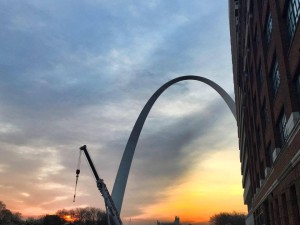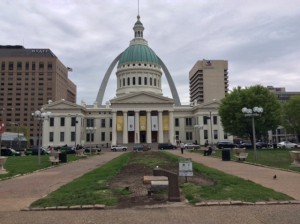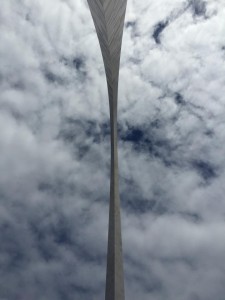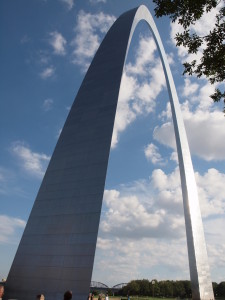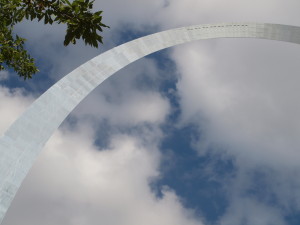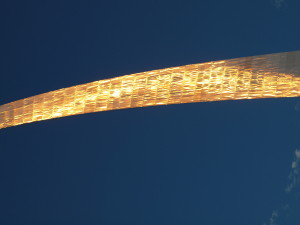It’s been four years since I launched Barbara A. Campagna/Architecture + Planning, PLLC and while many things have changed, my goal to work on “greening what’s already here” continues to be met, often in places I never expected. Many people are finding new ways to integrate historic preservation and green building practices, which makes my new venture a delightful and intellectually inspiring one. This is blog three of my anniversary week. And it’s Earth Day, a fine day to celebrate this glorious memorial.
The Gateway Arch at the Jefferson National Expansion Memorial
Last week I attended a truly fabulous symposium in St. Louis – Mid Century Modern Structures Symposium sponsored by NCPTT and the World Monuments Fund. One of the best parts of the symposium was spending our days adjacent to the Arch. Our conference space in the Drury Plaza Hotel in the former American Zinc Building looked out over the Arch. For years I have been obsessed with the Space Needle in Seattle ( a contemporary of the Arch) and since my first visit to the Arch in 2010, I have hoped to get back here.
We heard from many professionals involved in managing, maintaining, and evaluating the Arch. We heard from architectural historians about the Arch’s place in St. Louis and modernism. And while I was thrilled to have this insight into all these important aspects, there is nothing, absolutely nothing, like walking around the Arch (even with its landscape under construction as it is brilliantly remade), looking up at it from every possible vantage, and being encouraged to touch it. If you have never been there, please figure out a time and way to visit. The era of Modernism was a time of great hope and optimism, and these structures from worlds’ fairs (like the Space Needle) and memorials to our great founders (like Jefferson with the Arch) demonstrate how we can eloquently use modern materials and forms to express that hope and optimism.
Why an Arch?
Much has been written about the competition for the Arch and father and son Eliel and Eero Saarinen competing for its design. Designed in 1947/48, its construction did not begin until 1962 (and Eero Saarinen had just died unexpectedly). It opened in 1965. If you would like more details please peruse the National Park Service’s website. For an incisive architectural evaluation, Helene Lipstadt’s essay entitled “Co-Making the Modern Monument” in Modern Architecture in St. Louis is a great place to start.
There is a nice brochure available at the Arch bookstores entitled “Building The Arch: The Improbable Dream.” I will excerpt a piece about its form that is quite interesting:
A certain uneasiness mingled with anticipation in the autumn air over St. Louis as the days of October 1965 ticked away. The Gateway Arch stood one section from completion, two colossal tusks aching to touch 630 feet in the sky. The gap between them was an arm’s length, two and one-half feet. The section that had to fit it was eight feet long. Hydraulic jacks, exerting 625,000 pounds of force, would have to pry the arcs farther apart. Such a thing had never been done before.
This wasn’t like building a pyramid, a dome, an obelisk or even the world’s tallest office building. Architect Eero Saarinen had taken a mannerism of nature – a catenary curve, the arc of a chain suspended from two points – turned it upside down, and left it to an army of engineers and workers to figure out how to build it. The Arch had to be reinvented twice – first in Saarinen’s imagination, then for real beside the Mississippi River. (copyright 2010 Jefferson National Parks Association)
The Arch is Not Concrete
So maybe you will laugh at me, and some have. But others have agreed with me. Prior to my first trip to St. Louis in 2010 as part of a summer road trip, I had never really researched or read much about the Arch. I always admired both Saarinens, and have visited the soaring airports, their churches in Columbus, Indiana and their Kleinhan’s Music Hall in Buffalo – all masonry or concrete buildings. Until I actually saw it, I had always thought the Arch was concrete, or even possibly limestone. But I had never really thought about it. As we were driving over the Mississippi and I saw the Arch for the first time I screamed, “EXPLETIVE, the Arch is stainless steel!!!” My companions thought it was hysterical that I didn’t know it was stainless steel. But I dare you to open your mind and look at it in photographs and even in person at certain times – tell me it couldn’t possibly be concrete! Who would have designed it out of stainless steel?!
With that said, to see this structure, touch it, and photograph it is to witness the wonder of its stainless steel. For the past 15 years the National Park Service has been evaluating every component of the Arch – from its landscape and access to its structural capacity, its life safety and fire safety, and its need for maintenance and restoration.
We heard from Al O’Bright, the National Park Service Historical Architect for the Arch, that it has taken 15 years to evaluate just the stains and markings on the Arch because cyclical inspections and routine inspections were not considered in the design. Its reverse catenary shape makes it very difficult to observe and access the exterior stainless steel, in which all of the panels are welded together. Ultimately, specialized rock climbers ascended the Arch to make actual observations and take detailed photographs.
We heard from Steve Kelly, an architect and structural engineer who has studied the Arch for 10 years. He and his former firm, Wiss Janney Elstner, reviewed precedents to assist in determining if the Arch should be or needed to be cleaned. They looked at similar stainless steel monuments and buildings which had been cleaned including the Chrysler Building built in 1929 (light detergent), the Unisphere at the NY World’s Fair built in 1964 (blasted with water), the Inland Steel Building, American Zinc Building, and the relatively new Air Force Memorial.
We heard from scientist Catherine Houska of TMR Consulting that some of the staining was from de-icing salt and that de-icing salt can travel up to 1.2 miles. Given that a major highway has run adjacent to the Arch for decades, this is not surprising. She also reminded us that stainless steel is stain-less NOT stain-free!
We heard from preservation architect Anne Weber and fire protection engineer Jennifer Wiley that their use of performance based analysis with 3-D modeling suggests that if there is a fire at one base or side of the arch, visitors at the top should have more than enough time in most cases to descend the staircase to safety on the other side.
And we heard from Mary Reid Brunstrom, an architectural historian from Washington University, that the arch has become an indispensable symbol of St. Louis, which is often called “Parabola City.” Everything in St. Louis references or points to the Arch. Happy 50th Birthday to one of the great architectural wonders on the planet, the Gateway Arch, designed and envisioned by masterful modernist architect, Eero Saarinen. And Happy Earth Day too!
And if you’d like to “subscribe” or follow my blog, True Green Cities, please sign up through the “Subscribe” button at the bottom left of this page. You’ll receive a daily recap when new blogs are posted. Or Sign up for the Feed, also at the bottom left of this page.

